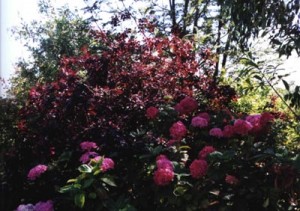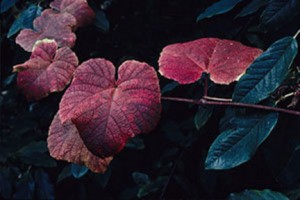This may be presumptuous but I once began a forum for ‘Great Plant Combinations.’ Sometimes beginning attempts may be really corny but here goes. Some of these are combinations that my customers liked but their ‘gardener’ did not. More on that later:
Picture of a purple smoke tree and red hydrangea.
1. Climbers: Visually I still like clematis growing through a climbing rose!
2. Trees and shrubs: on one steeply sloping site the dark glossy Camellia leaves make a great foil for a young magnolia as I look up from the valley floor.
3. Bulbs: white cyclamen and hostas go well together in the patchy wet and dry soil beneath an evergreen alder. Hostas can be surprisingly tough even if they resemble green pustules of eczema in the garden.
4. Night garden: I have a picture on my desk of white digitalis amongst Betula alba and an owl statue on a plinth. It looks gorgeous, the same can be said for the lowly white alyssum which simple glows hallucinogenically under a full moon.
5. Most of my customers where into container gardening as well. Containers provide leftover plants for color in early spring when there’s no seedlings in the shops: In wide shallow planters, narcissus can be arranged with viola and trailing oregano, you can do a blue color scheme using white narcissus and or a yellow one using variegated oregano. UGH!
Nearly everyone loved growing clematis through other shrubbery. It is especially fun because very few people who visit us are gardeners – so many people have left convinced that a golden Chaemacyparus flowers in purple in early summer, or that a Cornus florida flowers white in spring and purple in summer.
One of my customers also managed to persuade a rose to grow up a small tree – a while Rosa alba Meideland in a purple smoke tree “and has draped itself in such a manner that you would swear the tree is blooming huge clusters of white flowers.” I viewed it as assault and battery and would be called upon to prune both. She also enjoyed finding plants that I can grow through other plants – Lycoris springing up as though a hosta was its basal foliage, etc.
I admit that all of these suggestions are wonderful and inspired, but the ‘hired help’ may have a prickly problem with some. I will leave that for the end.
Mixing purple clematis with other shrubs is a great idea, and still maintainable. My own combination was Golden Hops — actually I also have some gigantic Allium’s planted near the Hops as well. The other tree I planted it in was a golden Dogwood – I never thought of planting it with an evergreen such as Chamaecyparis. I will add that some of my own best combination was as a Nurseryman who made accidental discoveries when combining flats for sale. On a landscape and fragrance level my ultimate was combining a ground cover silver curry plant (Helichrsum angustifolium Dwarf) under my Moss Roses. The combination could have made a great men’s cologne.
White to white works well too. The white Digitalis amongst Betula — suggested the alternative use of either (weedy) Sweet Woodruff or Snow in the Summer (Cerastium). More in tune with Digitalis would be the bluish foliaged Dicentra’s. They are all of formasa parentage, and their white flowers look great with Pulmonaria, Hosta and the taller Primula.
You didn’t like the prickly pruning??? After pruning down an overgrown and very spiny Berberis, in which Rosa wichuriana was growing through, under, about and up. I HATE ALL roses growing through anything. Bad enough pruning tall fruit trees, but when I have to prune them with a twenty foot rose mixed in, I just begin to whimper!
Seeing those two twenty-five foot apple tree’s blooming once again in mid-summer just reminds me of the pain yet to come. Same for my customer who loved planting Clematis and Rose together. Damn difficult pruning!
Now planting a rose or grape into a native Big Maple, that is something else again. I happened to plant a grape, Vitis coignetiae (Crimson fall color) into this soon to be yellow tree. The combination turned out great. Hmmn — there is that Purple Beech waiting for something! Perhaps a golden hop vine. Nah, the hop just looks awful when it becomes deciduous. Clematis henryi might work; just as long as it isn’t a wisteria or climbing rose.
My favorite planting combination for tubs, always has been Godetia, Salpiglossis and Nemesia. Then again, CA. raised I like HOT and BRIGHT. Just call me Bougainvillea Herb. In Santa Cruz, I planted an entire hillside with gold flowered Fremontia (a small tree), the shrubs were tall Ceanothus ‘Dark Star’ (cobalt blue), and the ground cover was Grevillia ‘Aromas’, an intense red.
Ahh, I can still hear those bees now! Even they started to put on sunglasses.
Vitis vinifera ‘Purpurea’
The grapes are small and bitter, but can be eaten even though full of pips they are best used as garnishes or left on the plants for decoration. When ripe, even the birds are reluctant to feed on them. Purple-leaf grape vine can be grown through trees and large shrubs or on a trellis or arbor. Best grown in full sun!/su_column]
One problem about growing either of these in a tree would be mildew as all grapes are prone to this.
(C) Herb Senft 20014



